I finally found some birds yesterday, with a few White-lined Sphinx Moths thrown in for good measure.
Birds have been slow for me lately, to the point that two days ago in the mountains I was completely bird-skunked. I didn’t even download the few photos I took that day from my memory card. Yesterday morning I needed to visit Antelope Island for a reason unrelated to bird photography so despite the wildfire smoke I took my camera gear along just in case I found an interesting bird or critter.
The smoke was terrible, worse than I’ve ever seen it on the island. But I did find some very aggressive Rufous Hummingbirds and some sphinx moths (hummingbird moths) on one of the patches of Rocky Mountain Bee Plant. I’ll save my photos of hummers feeding on bee plant flowers for another day but this morning I thought I’d share some photos of them battling with each other and a couple of shots of the sphinx moths.
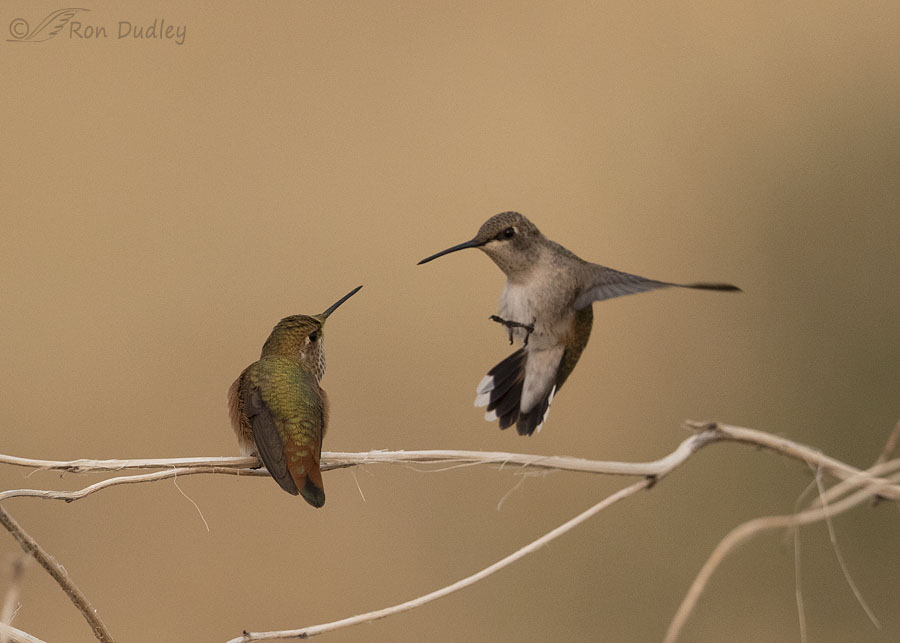
1/5000, f/5.6, ISO 1250, Canon 7D Mark II, Canon EF 500mm f/4L IS II USM + EF 1.4 III Extender, not baited, set up or called in
Most of the hummers appeared to be male Rufous Hummingbirds and one of them in particular was extremely protective of the flower patch. Here he was resting between feeding and jousting bouts when a female hummer (I’m unsure of the species) challenged him aggressively.
I find it to be nearly impossible to get two hummingbirds sharp with catch lights in their eyes, especially when one or both of them is in flight. In this photo there’s no light in the eye of the male and the female in flight is a little soft, but not bad.
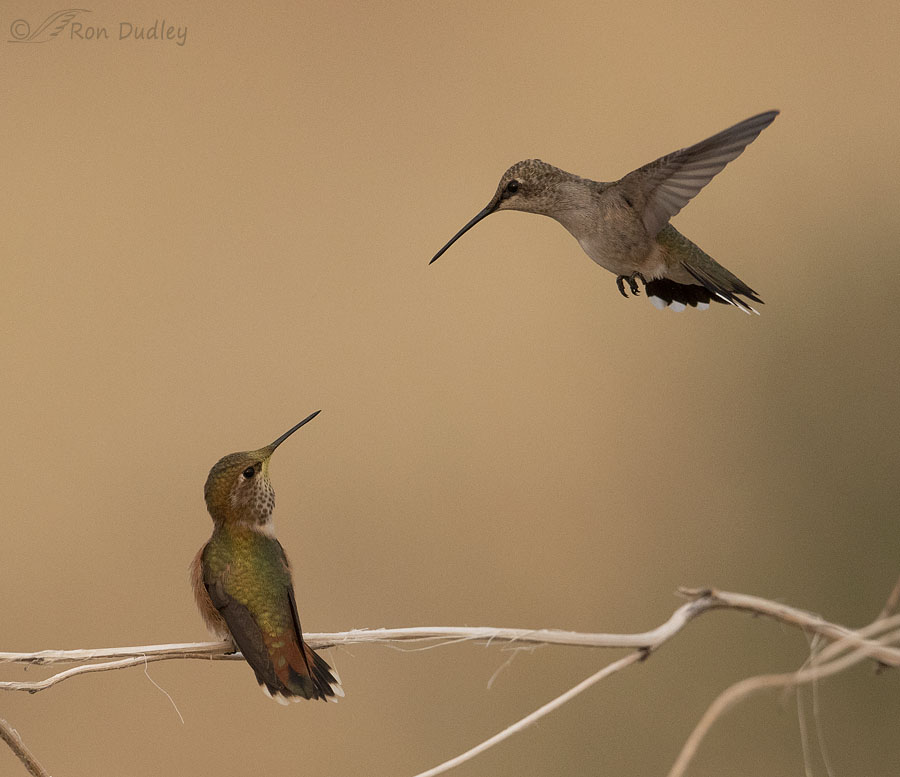
1/5000, f/5.6, ISO 1250, Canon 7D Mark II, Canon EF 500mm f/4L IS II USM + EF 1.4 III Extender, not baited, set up or called in
But I did get lucky with two photos during the encounter where both birds are sharp and…
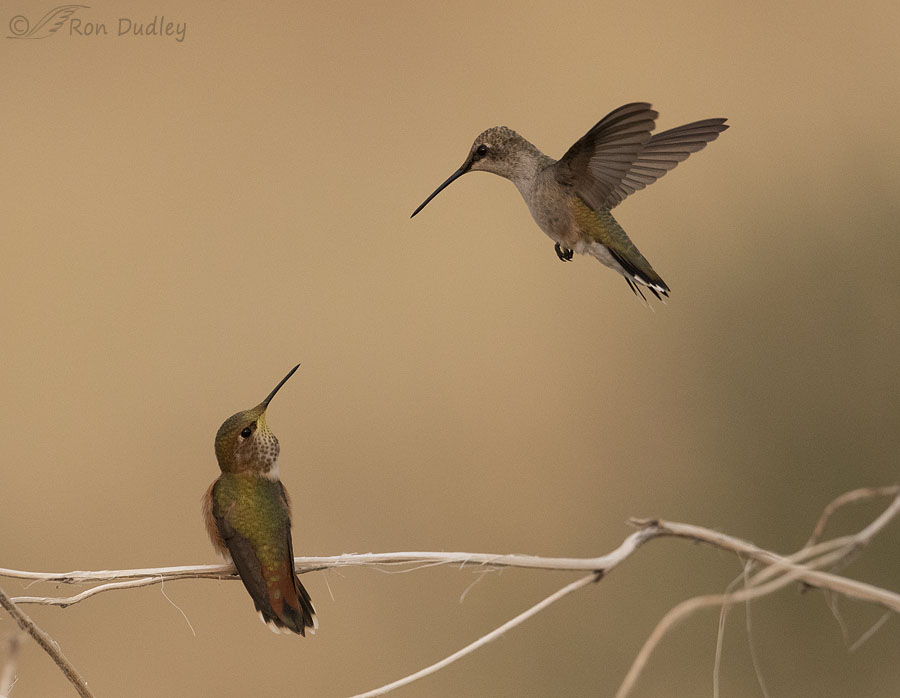
1/5000, f/5.6, ISO 1250, Canon 7D Mark II, Canon EF 500mm f/4L IS II USM + EF 1.4 III Extender, not baited, set up or called in
have catch lights in their eyes, even in the smoke.
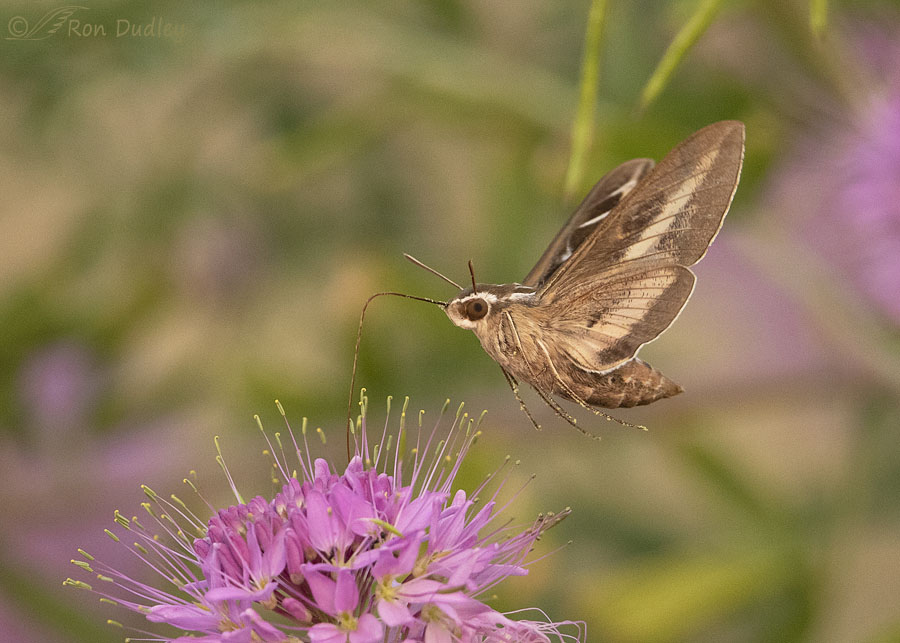
1/2500, f/5.6, ISO 1250, Canon 7D Mark II, Canon EF 500mm f/4L IS II USM + EF 1.4 III Extender, not baited, set up or called in
There were also several White-lined Sphinx Moths nectaring at the flower patch. In the smoke and low light I was having an unusual amount of trouble locking focus on them in flight but I got a few shots I like reasonably well.
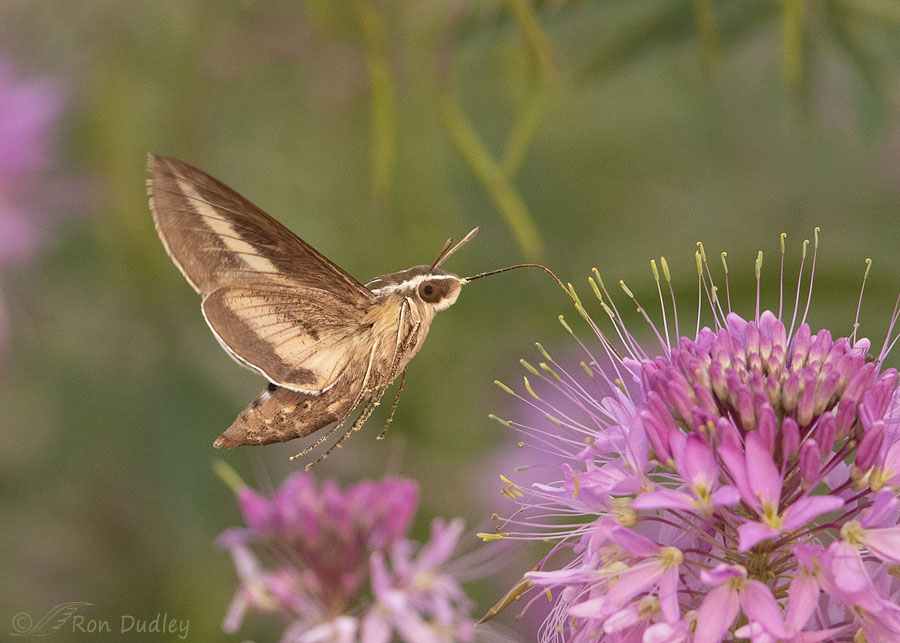
1/2500, f/5.6, ISO 1250, Canon 7D Mark II, Canon EF 500mm f/4L IS II USM + EF 1.4 III Extender, not baited, set up or called in
This photo is almost a mirror image of the previous one but the moth is a little larger in the frame.
On one occasion when I had a moth in my viewfinder I saw a lightning-quick flash of movement from the left frame edge to the right. It was the male (or juvenile) Rufous Hummingbird attacking the moth. It happened so quickly I had no chance to push the shutter button in time so I had to take my eye away from the viewfinder to check on the welfare of the moth. I was afraid the hummer had speared the moth with its dagger-like bill.
Thankfully the moth survived to fly another day.
Ron
Note: The Rufous Hummingbirds at my feeder have been gone for about a week now so I was slightly and pleasantly surprised to find some on the island.


Love these images, just fantastic!!
Fabulous shots, Ron! Love the intensity between the two hummers. The Sphinx Moth is gorgeous — would it be large enough to count as an “LBJ?”
Saw a couple of flashes of orange body/brown wings while at the shelter yesterday. The hummers were too fast for me to determine Rufous vs. Allen’s (even if I possessed that skill). The Mastiff mix I had out was no help in that department either.

“would it be large enough to count as an “LBJ?”
Marty, they may be large enough to qualify based on size but they actually have some gorgeous color on their wings that we can’t see in these photos.
Wonderful photos! I really like the second and third double hummer images, congrats! I need to get out and try for a few shots before the birds and flowers are gone. I still have both rufous and juvenile black chinned and broad tailed. Not as many but enough to enjoy the hummer wars.
How was the effort to get to the Island? Last time I was there it was a maze of unmarked detours.
April, it’s still a maze but the detours are marked.
And then, with all the recent construction and habitat destruction on the island and causeway, it was a thoroughly depressing experience. I think they’re ruining the island. If I wanted a Disneyland experience I’d go to Anaheim.
Yes, with all the “upgrades” and increase in visitation it is no longer the same place.
Love the puffed-up gorget feathers on the bird on the left – so expressive!
Good eye, S. Thanks.
Those rapier bills!!!! The birds that wield that impressive weaponry!!!
And the simply gorgeous moth!!! I think that moths are often more beautiful that the more widely celebrated butterfly.
And that dreadful light which I remember so well!
Thank you for this morning’s exotica.
“I think that moths are often more beautiful that the more widely celebrated butterfly”
Very often you’re absolutely right, EC.
A real study in contrasts. I never thought I would look at one of your hummingbird photos and think it was drab, but you’ve done it by posting it along with the bright and cheery moth at the bee plant. Nevertheless, lots to like about all these shots.
Fires, smoke, drought, shrinking Salt Lake; you do manage to, as they say on public radio’s Says You!, find the rose among the thorns.
Thanks, Lyle. I’m afraid finding the rose among the thorns is becoming more difficult these days.
These moths are great. Usually, I see them signally or only a few at a time but I once came across a group that I estimated to have at least 200 moths in it. The sound of the wings was very impressive. I also once had a fellow call me about a new species of hummingbird he had seen. It was clear from his description that it was one of these moths. I explained about these moths, thinking he would find it interesting. Instead, I was informed that I was “very stupid”. He told me that moths are much smaller and never out in the daytime and if I didn’t know that fact I had no business writing about nature. (At the time I was writing a monthly column published in our local newspaper.) He told me that his “hummingbird” was of interest to any “real scientist” because it had more legs than other birds. Oh well. Most readers found it of interest when I wrote about these moths a few months later.
Dan, I hope you included some details about the claims of that “fellow” in your article. And that he read it.
We don’t invest nearly enough research money into finding a cure for stupidity. Or jerkdom.
Great shots Ron. I have trouble getting the fighting Hummers in the frame let alone getting catch lights. The Sphinx Moths just arrived last week and are very busy with our Autumn Sage and other flowering plants. The Anna’s don’t seem to bother them very much so far, but of course when the Rufous arrive they will for sure go after them.
Thanks, Everett. Rufous hummers are like that aren’t they!
I liked all 3 of the Rufous/duo photos very much ! They have a spare,
almost asian art quality to them–the linear quality of the bush perch echoes
their bill to bill address of each other—very unusual and beautiful !
Good! Those photos in that light and smoke are different enough that I wasn’t sure how much appeal they would have. Thanks, Kris.
Beautiful and fun that you captured the action between the hummers. 1st time I saw one of the sphinx moths many years ago I thought it was a hummer until I got a closer look.
1st time I saw one of the sphinx moths many years ago I thought it was a hummer until I got a closer look.  At that time we weren’t getting any hummers. Glad the one attacked by the hummer survived!
At that time we weren’t getting any hummers. Glad the one attacked by the hummer survived!
After being in the 80’s and, pretty much smoke free, it’s 39 this morning!
Thanks, Judy.
Yesterday morning it was in the mid 50’s but this morning it’s 72. Clouds holding the heat in.
Beautiful photos! wonderful story! The moth lives for a few more hours
Thank you, Terri.